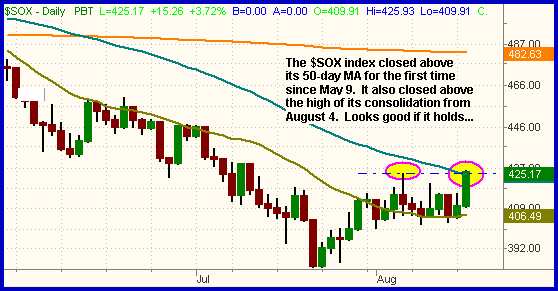Test the water on these ETFs
As we have seen numerous times
throughout the past two weeks, stocks gapped higher yesterday
morning, but this time the gains actually held up throughout the session. The
broad market trended higher throughout the morning, consolidated for a few hours
during the doldrums, then resumed its intraday uptrend in the final ninety
minutes of trading. Each of the major indices racked up solid gains and finished
at their highest levels of the day. The Nasdaq Composite
(
COMP |
Quote |
Chart |
News |
PowerRating) zoomed 2.2%
higher, the S&P 500 rallied 1.4%, and the Dow Jones Industrial Average
(
DJX |
Quote |
Chart |
News |
PowerRating)
gained 1.2%. Small and mid-cap stocks led the market for a change. The Russell
2000
(
RUT |
Quote |
Chart |
News |
PowerRating) surged 2.4% and the S&P Midcap 400
(
MDY |
Quote |
Chart |
News |
PowerRating) finished 1.9%
higher.
It was also positive to see that higher volume finally
confirmed a day of broad-based gains. Total volume in the NYSE rose by 9%, while
turnover in the Nasdaq was 19% above the previous day’s level. The gains on
higher volume enabled both the S&P 500 and Nasdaq Composite to register bullish
“accumulation days,” but it is important to note that volume in both exchanges
was still below 50-day average levels. Considering how choppy and indecisive the
market has been lately, it would have been better to see a clear signal that
institutions have unequivocally begun buying stocks. But one simply cannot make
that conclusion when turnover failed to even exceed average levels on a day when
the major indices moved firmly higher. Obviously, this seasonally slow time of
the year is going to have a major bearing on volume levels, but that is all the
more reason to be cautious with any new trades.
On a technical level, there were a few interesting changes
that occurred as a result of yesterday’s strength. Foremost, the Semiconductor
Index
(
SOX |
Quote |
Chart |
News |
PowerRating) rallied 3.7% and broke out above a 3-week sideways range. It
also closed above its 50-day moving average for the first time since the selloff
began in early May:

Although momentum should carry the semiconductor stocks higher
in the short-term, remember that false breakouts are common in an overall weak
market. Therefore, astute traders will wait for confirmation that the breakout
in the $SOX will hold for more than a day before initiating new long positions.
If the $SOX proves it will hold, several of the semiconductor ETFs will present
buying opportunities, but selling into strength of the first leg up is advisable
due to the amount of overhead resistance that remains. As the
Morpheus ETF Roundup shows, there are presently four different ETFs that are
correlated to the $SOX. Their ticker symbols are: SMH, IGW, PSI, and XSD. Of the
four, IGW (iShares Semiconductor Fund) is showing the most relative strength
because it is the only one that has both rallied above its 50-day MA and
closed above the high of its multi-week consolidation. The Semiconductor HOLDR
(
SMH |
Quote |
Chart |
News |
PowerRating)
also looks pretty good because it popped above its 50-day MA, but it remains
just below its August 4 high. If you buy any of these semiconductor ETFs, set a
target by using Fibonacci price retracements of 38.2% to 50% of the total range
from the May high down to the July low. A protective stop should not be much
looser than below the low of the multi-week trading range.
In addition to the $SOX, both the Nasdaq Composite and Nasdaq
100 indices closed above their 50-day moving averages for the first time since
May 9. Like IGW, the Nasdaq 100 Index Tracking Stock (QQQQ) also finished above
both its 50-day MA and its August 4 high:

The QQQQ and IGW daily chart patterns are similar, so both
ETFs present a decent risk-reward ratio. But because recent strength has been
largely focused in the tech arena, we would probably favor buying IGW, or any of
the other semiconductor ETFs, over QQQQ. It’s not a bad play to test the water
on these ETFs, but don’t forget that they are well off their 52-week highs. As
such, there is a lot of overhead supply that will result in traders and
investors selling into strength. If you buy a new position and it acts well, go
ahead and add a few shares, but don’t get greedy on the upside profit potential.
Other sectors and market indices have not confirmed the recent Nasdaq strength
and could easily weigh down the tech stocks, so it’s best to test the water with
one foot before jumping in head first.
Open ETF positions:
Long PPH and SDS, short IWM (regular subscribers to
The Wagner Daily
receive detailed stop and target prices on open positions and detailed setup
information on new ETF trade entry prices. Intraday e-mail alerts are also sent
as needed.)
Deron Wagner is the head trader of Morpheus Capital Hedge Fund and founder of
Morpheus Trading Group (morpheustrading.com),
which he launched in 2001. Wagner appears on his best-selling video, Sector
Trading Strategies (Marketplace Books, June 2002), and is co-author of both The
Long-Term Day Trader (Career Press, April 2000) and The After-Hours Trader
(McGraw Hill, August 2000). Past television appearances include CNBC, ABC, and
Yahoo! FinanceVision. He is also a frequent guest speaker at various trading and
financial conferences around the world. For a free trial to the full version of
The Wagner Daily or to learn about Deron’s other services, visit
morpheustrading.com or send an e-mail to
deron@morpheustrading.com .
Â
